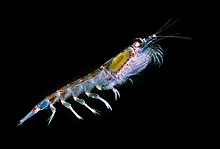
Back كريل رائع Arabic كريل رائع ARZ Антарктически крил Bulgarian অ্যান্টার্কটিকা ক্রিল Bengali/Bangla Krill antàrtic Catalan Euphausia superba CEB Krunýřovka krillová Czech Antarktisk krill Danish Antarktischer Krill German Euphausia superba Esperanto
| Antarctic krill | |
|---|---|

| |
| Scientific classification | |
| Domain: | Eukaryota |
| Kingdom: | Animalia |
| Phylum: | Arthropoda |
| Class: | Malacostraca |
| Order: | Euphausiacea |
| Family: | Euphausiidae |
| Genus: | Euphausia |
| Species: | E. superba
|
| Binomial name | |
| Euphausia superba Dana, 1850
| |
| Synonyms [2] | |
| |
Antarctic krill (Euphausia superba) is a species of krill found in the Antarctic waters of the Southern Ocean. It is a small, swimming crustacean that lives in large schools, called swarms, sometimes reaching densities of 10,000–30,000 animals per cubic metre.[3] It feeds directly on minute phytoplankton, thereby using the primary production energy that phytoplankton originally derive from the sun in order to sustain its pelagic life cycle.[4] It grows to a length of 6 centimetres (2.4 in), weighs up to 2 grams (0.071 oz), and can live for up to six years. A key species in the Antarctic ecosystem and in terms of biomass, E. superba is one of the most abundant animal species on the planet, with a cumulative biomass of approximately 500 million metric tons (550 million short tons; 490 million long tons).[5]
- ^ Kawaguchi, S.; Nicol, S. (2015). "Euphausia superba". IUCN Red List of Threatened Species. 2015: e.T64239743A64239951. doi:10.2305/IUCN.UK.2015-2.RLTS.T64239743A64239951.en. Retrieved 19 November 2021.
- ^ Volker Siegel (2010). Volker Siegel (ed.). "Euphausia superba Dana, 1850". World Euphausiacea database. World Register of Marine Species. Archived from the original on 24 May 2011. Retrieved May 10, 2011.
- ^ William M. Hamner; Peggy P. Hamner; Steven W. Strand; Ronald W. Gilmer (1983). "Behavior of Antarctic krill, Euphausia superba: chemoreception, feeding, schooling and molting". Science. 220 (4595): 433–435. Bibcode:1983Sci...220..433H. doi:10.1126/science.220.4595.433. PMID 17831417. S2CID 22161686.
- ^ Uwe Kils; Norbert Klages (1979). "Der Krill" [The Krill]. Naturwissenschaftliche Rundschau (in German). 32 (10): 397–402. Archived from the original on 2016-03-05. Retrieved 2011-05-10.
- ^ Stephen Nicol; Yoshinari Endo (1997). Krill Fisheries of the World. Fisheries Technical Paper 367. Food and Agriculture Organization. ISBN 978-92-5-104012-6.
